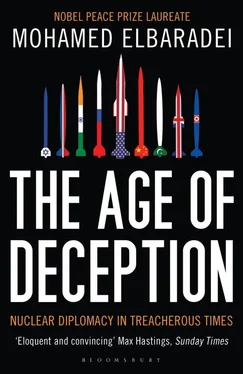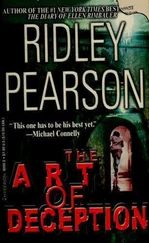Naturally, Pyongyang saw this as the United States reneging on yet another commitment. North Korean nuclear experts promptly got the order to begin reinstalling equipment at the dismantled facilities. On October 8, 2008, IAEA inspectors were prohibited from further monitoring the shutdown in Yongbyon.
Three days later, the United States backed down. North Korea was removed from the list of terrorism-sponsoring countries. The next day, North Korea resumed the dismantling process. The IAEA was again granted access to the Yongbyon facilities.
But the spring of 2009 would bring another setback. Despite international pressure not to do so, North Korea went forward on April 5 with a “satellite launch,” which was perceived to be a test of its longest-range missile. President Barack Obama called the test a “provocation” and urged the UN Security Council to take action. On April 13, the council condemned North Korea for the launch. Pyongyang responded with predictable anger, declaring that North Korea would never again take part in the six-party talks. Once again, the IAEA’s inspectors were asked to leave the country.
North Korea at the time was in an ongoing crisis. Poverty was at extreme levels: the allocation of rice per person had fallen to two hundred grams per day, well below a minimally nutritional diet. Meanwhile, the poor health of Kim Jong Il was causing a struggle between the aging dictator, who wanted to install one of his sons, Kim Jong Un, as successor, and high-ranking army generals, who saw an opportunity to grab power. Any external confrontation was an excuse for the hardliners to call for dramatic action.
The pendulum had not quite reached the end of its swing. On May 25, 2009, North Korea successfully tested its second nuclear weapon. It was still small by nuclear weapon standards but markedly more powerful than the first. The test was condemned by the UN Security Council and by the five other governments of the now-dormant six-party talks.
The long-alleged enrichment program also resurfaced, this time as a fully outfitted uranium enrichment facility, proudly unveiled by the North Koreans in November 2010 to Siegfried S. Hecker, a Stanford University professor who had once directed the Los Alamos National Laboratory. [15] David E. Sanger, “North Koreans Unveil New Plant for Nuclear Use,” New York Times , November 20, 2010.
Hecker and his colleagues were shown a sophisticated control room and an enrichment hall equipped with what the North Koreans said were two thousand centrifuges already producing low-enriched uranium. The facility was housed in a former fuel fabrication center, making clear that the enrichment plant had been constructed after April 2009, when inspectors had last been in the country. The speed of construction led many to conjecture that North Korea must have other uranium enrichment operations elsewhere in the country. [16] David E. Sanger, “U.S. Concludes North Korea Has More Nuclear Sites,” New York Times, December 14, 2010.
The revelation was yet another stunning testament to the futility of attempts to contain proliferation ambitions through confrontation, sanctions, and isolation.
• • •
To my way of thinking, the second North Korean nuclear test was far more frustrating than the first. Much had been accomplished on the North Korean file during the intervening two years. And the detonation had come at a time when, given the policies of the new American administration, the prospects for progress on global nuclear disarmament were better than they had been at any time in the recent past.
But the biggest source of frustration by far has been watching the cycle of ups and downs in North Korea’s relationship with the West. North Korea’s actions and reactions have been largely predictable. When Pyongyang has been engaged in a meaningful dialogue, the situation has generally improved. When dialogue has stopped, when perceived insults have occurred, when a policy of isolation has been reintroduced, the situation has deteriorated. It is that maddeningly simple.
Thus the Security Council’s condemnation of North Korea’s missile launch had of course made the situation worse. Quite possibly, with the new U.S. administration in power, North Korea had been deliberately provocative, in the hope of attracting attention from the Obama administration and extracting better treatment than it had received from the Bush administration. In any case, the North Koreans were certain to overreact, as they had in every earlier situation. Is it possible, I wondered, that diplomats and politicians had become so focused on the specific issue of the day that they had lost sight of the endgame of disarmament?
Invariably, whether dealing with North Korea or another nuclear proliferation case, the Security Council seemed to be either too divided or too restricted in its options to produce anything other than toothless statements or actions that prompted unintended consequences. In case after case, the stances taken by the Security Council in response to threats of nuclear proliferation were hollow and ineffectual. For the council to become effective, several adjustments were clearly necessary: a focus on the root causes of insecurity, and not just the symptoms; greater agility and realism in dealing with noncompliance, intervening early rather than postmortem; effective enforcement measures that would target the regimes in question, not innocent civilians; and consistency of approach when dealing with similar situations. [17] Of course, the council also needs to be reconstituted to be representative of the twenty-first century. It is absurd that the P-5, the council’s permanent membership, does not include countries such as Brazil, India, and South Africa.
Nowhere would these needs for adjustment be more striking than in dealing with the nuclear program of the Islamic Republic of Iran.
5
IRAN, 2003–2005
The Riddle of Taqqiya
As if two ongoing nuclear verification dramas were not enough, in mid-2002 the IAEA began receiving information about a third. Satellite photos of Natanz, a small town in Isfahan province in central Iran, showed the construction of a large industrial facility with discernable details suggesting that it might be a uranium enrichment plant. In mid-August, the National Council of Resistance of Iran [1] The NCRI is an Iranian opposition group based in Paris, self-styled as a coalition of democratic Iranian individuals and groups prepared to form a provisional government if the current regime were to be toppled. Both Iran and the United States have classified the NCRI as a terrorist organization, citing its ties to the Mujahedin-e Khalq, a religious leftist affiliate of NCRI with a history of violence. The NCRI has repeatedly made allegations about Iran’s clandestine nuclear program, some of which have been substantiated by subsequent IAEA investigation. Whether the NCRI was used by Western intelligence to disseminate information about Iran’s nuclear activities was a question I often pondered.
held a press conference in Washington alleging that Iran was building a secret nuclear facility at Natanz.
The Agency began investigating. In September, at the annual IAEA General Conference in Vienna, I looked for Gholamreza Aghazadeh, a small, serious man with two titles: vice president of Iran and the head of AEOI, the Atomic Energy Organization of Iran. I pulled him aside. “Tell me about this Natanz facility,” I said. “Is this for enrichment, as the satellite photos suggest? Perhaps we should make a visit.”
Aghazadeh smiled. “Of course we will invite you soon,” he replied warmly. “And then we will clarify everything.”
The ambiguity of Aghazadeh’s response was less than reassuring. Still more disturbing was the long list of excuses we began to hear for postponing the promised visit: President Khatami was “traveling”; President Khatami was “sick”; the chosen dates were “inconvenient.” This went on for months.
Читать дальше












